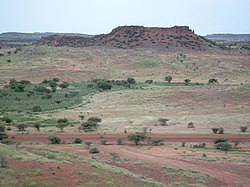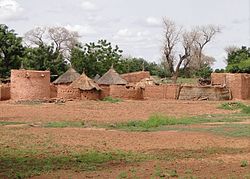| Sahel | |
|---|---|
| Region | |
 | |
 Location in Burkina Faso Location in Burkina Faso | |
| Coordinates: 14°15′N 00°45′W / 14.250°N 0.750°W / 14.250; -0.750 | |
| Country | |
| Capital | Dori |
| Government | |
| • Governor | Salfo Kabore |
| Area | |
| • Region | 35,360 km (13,650 sq mi) |
| Population | |
| • Region | 1,094,907 |
| • Density | 31/km (80/sq mi) |
| • Urban | 129,038 |
| Time zone | UTC+0 (GMT 0) |
| HDI (2021) | 0.286 low · 13th of 13 |
Sahel ([sa.ɛl], "Sahel") is one of Burkina Faso's 13 administrative regions. It was created on 2 July 2001. The region's capital is Dori. Four provinces make up the region—Oudalan, Séno, Soum, and Yagha. This region is the northernmost part of the country and is adjacent to Mali and Niger.
As of 2019, the population of the region was 1,094,907 which is 5.34% of the total population of the country.
Geography

Most of Burkina Faso is a wide plateau formed by riverine systems and is called Falaise de Banfora. There are three major rivers, the Red Volta, Black Volta and White Volta, which cuts through different valleys. The climate is generally hot, with unreliable rains across different seasons. Gold and quartz are common minerals found across the country, while manganese deposits are also common. The dry season is usually from October to May and rains are common during the wet season from June to September. The soil texture is porous and hence the yield is also poor. The average elevation is around 200 m (660 ft) to 300 m (980 ft) above mean sea level. Among West African countries, Burkina Faso has the largest elephant population and the country is replete with game reserves. The northern regions are generally arid and usually have scrub land and semi-deserts. The principal river is the Red Volta, that originates in the northern region and drains into Ghana. The areas near the rivers usually have flies like tsetse and similium, which are carriers of sleep sickness and river blindness. The average rainfall in the region is only around 25 cm (9.8 in) compared to southern regions that receive 100 cm (39 in) rainfall.
Demographics
| Year | Pop. | ±% p.a. |
|---|---|---|
| 1985 | 521,911 | — |
| 1996 | 708,332 | +2.82% |
| 2006 | 968,442 | +3.18% |
| 2019 | 1,094,907 | +0.95% |
| Sources: | ||
The main languages spoken in Sahel Region as of 2006 were Fulfulde, Tamasheq (or "Bella"), and Moore. French is the official language throughout the country. As of 2019, the population of the region was 1,094,907 with 49.3% females. The population in the region was 5.34% of the total population of the country. The child mortality rate was 132, infant mortality rate was 119 and the mortality of children under five was 235. As of 2007, among the working population, there were 72.2% employees, 9.3% under employed, 16% inactive people, 18.5% not working and 2.5% unemployed people in the region.
Economy
As of 2007, there were 683.5 km (424.7 mi) of highways, 249.6 km (155.1 mi) of regional roads and 520.7 km (323.5 mi) of county roads. The first set of car traffic was 9, first set of two-wheeler traffic was 2,344 and the total classified road network was 1,454. The total corn produced during 2015 was 3,235 tonnes, cotton was 000 tonnes, cowpea was 17,804 tonnes, ground nut was 2,829 tonnes, millet was 152,287 tonnes, rice was 2,510 tonnes and sorghum was 72,967 tonnes. The coverage of cereal need compared to the total production of the region was 81.00 per cent.
As of 2007, the literacy rate in the region was 18 per cent, compared to a national average of 28.3 per cent. The gross primary enrolment was 40.8 per cent, post-primary was 7.6 per cent and gross secondary school enrolment was 1.9. There were 0 boys and 0 girls enrolled in the primary and post-secondary level. There were 0 teachers in primary & post-secondary level, while there were 239 teachers in post-primary and post-secondary level.
Administration
| Province | Capital | 2006 |
|---|---|---|
| Oudalan Province | Gorom-Gorom | 197,240 |
| Séno Province | Dori | 264,815 |
| Soum Province | Djibo | 348,341 |
| Yagha Province | Sebba | 159,485 |
Burkina Faso gained independence from France in 1960. It was originally called Upper Volta. There have been military coups till 1983 when Captain Thomas Sankara took control and implemented radical left wing policies. He was ousted by Blaise Compaore, who continued for 27 years till 2014, when a popular uprising ended his rule. As per Law No.40/98/AN in 1998, Burkina Faso adhered to decentralization to provide administrative and financial autonomy to local communities. There are 13 administrative regions, each governed by a Governor. The regions are subdivided into 45 provinces, which are further subdivided into 351 communes. The communes may be urban or rural and are interchangeable. There are other administrative entities like department and village. An urban commune has typically 10,000 people under it. If any commune is not able to get 75 per cent of its planned budget in revenues for 3 years, the autonomy is taken off. The communes are administered by elected Mayors. The communes are stipulated to develop economic, social and cultural values of its citizens. A commune has financial autonomy and can interact with other communes, government agencies or international entities.
References
- Citypopulation.de Population of regions in Burkinafaso
- "Sub-national HDI - Area Database - Global Data Lab". hdi.globaldatalab.org. Retrieved 2018-09-13.
- ^ Haggett, Peter, ed. (2002). Encyclopedia of World Geography, Volume 17. Marshall Cavendish. ISBN 9780761473060.
- Dobson, James C.; Sander, John M.; Woodfield, Judith (2001). Living Geography: Homework and Assessment, Book 3. Nelson Thornes. p. 29. ISBN 9780174343257.
- ^ Burkina Faso Mining Laws and Regulations Handbook. Int'l Business Publications. 2008. p. 19. ISBN 9781433077074.
- "Burkina Faso: Regions and cities". www.citypopulation.de.
- BOUGMA M., 2014. Dynamique des différentes langues en présence au Burkina Faso : les changements démo-linguistiques opérés au sein de la population burkinabè, 2014, Actes du XVIIe colloque international de l’AIDELF sur Démographie et politiques sociales, Ouagadougou, novembre 2012, 15 p.
- ^ "Demographics of Burkina Faso". National Institute of Statistics and Demographics, Burkina Faso. 2010. Retrieved 17 November 2016.
- "Employment statistics of Burkina Faso". National Institute of Statistics and Demographics, Burkina Faso. 2007. Retrieved 17 November 2016.
- "Transport in Burkina Faso". National Institute of Statistics and Demographics, Burkina Faso. 2008. Retrieved 17 November 2016.
- "Agricultural statistics of Burkina Faso". National Institute of Statistics and Demographics, Burkina Faso. 2015. Retrieved 17 November 2016.
- "Education statistics of Burkina Faso". National Institute of Statistics and Demographics, Burkina Faso. 2010. Retrieved 17 November 2016.
- "National 2006 census preliminary results" (PDF). 2006. Retrieved 24 November 2016.
- "Burkina Faso country profile". BBC. 5 August 2016. Retrieved 20 November 2016.
- Republic of Burkina Faso, Public Administration and Country profile (PDF) (Report). Department of Economic and Social Affairs (DESA), United Nations. 2004. p. 9. Retrieved 17 November 2016.
External links
| Regions of Burkina Faso | ||
|---|---|---|